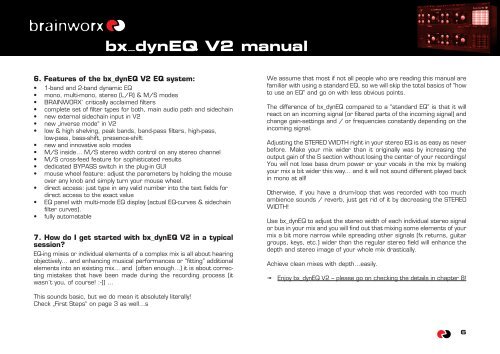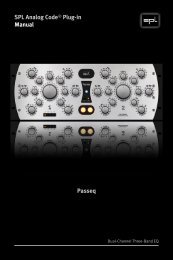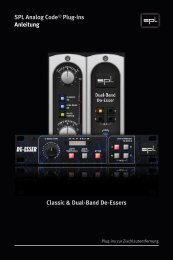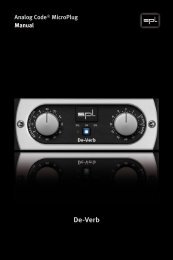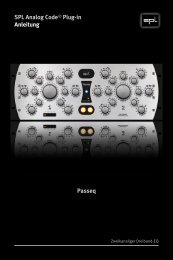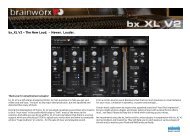PDF Manual - Plugin Alliance
PDF Manual - Plugin Alliance
PDF Manual - Plugin Alliance
Create successful ePaper yourself
Turn your PDF publications into a flip-book with our unique Google optimized e-Paper software.
x_dynEQ V2 manual<br />
6. Features of the bx_dynEQ V2 EQ system:<br />
• 1-band and 2-band dynamic EQ<br />
• mono, multi-mono, stereo (L/R) & M/S modes<br />
• BRAINWORX´ critically acclaimed filters<br />
• complete set of filter types for both, main audio path and sidechain<br />
• new external sidechain input in V2<br />
• new „inverse mode“ in V2<br />
• low & high shelving, peak bands, band-pass filters, high-pass,<br />
low-pass, bass-shift, presence-shift<br />
• new and innovative solo modes<br />
• M/S inside… M/S stereo width control on any stereo channel<br />
• M/S cross-feed feature for sophisticated results<br />
• dedicated BYPASS switch in the plug-in GUI<br />
• mouse wheel feature: adjust the parameters by holding the mouse<br />
over any knob and simply turn your mouse wheel.<br />
• direct access: just type in any valid number into the text fields for<br />
direct access to the exact value<br />
• EQ panel with multi-mode EQ display (actual EQ-curves & sidechain<br />
filter curves).<br />
• fully automatable<br />
7. How do I get started with bx_dynEQ V2 in a typical<br />
session?<br />
EQ-ing mixes or individual elements of a complex mix is all about hearing<br />
objectively… and enhancing musical performances or “fitting” additional<br />
elements into an existing mix… and (often enough…) it is about correcting<br />
mistakes that have been made during the recording process (it<br />
wasn´t you, of course! :-)) …<br />
We assume that most if not all people who are reading this manual are<br />
familiar with using a standard EQ, so we will skip the total basics of “how<br />
to use an EQ” and go on with less obvious points.<br />
The difference of bx_dynEQ compared to a “standard EQ” is that it will<br />
react on an incoming signal (or filtered parts of the incoming signal) and<br />
change gain-settings and / or frequencies constantly depending on the<br />
incoming signal.<br />
Adjusting the STEREO WIDTH right in your stereo EQ is as easy as never<br />
before. Make your mix wider than it originally was by increasing the<br />
output gain of the S section without losing the center of your recordings!<br />
You will not lose bass drum power or your vocals in the mix by making<br />
your mix a bit wider this way… and it will not sound different played back<br />
in mono at all!<br />
Otherwise, if you have a drum-loop that was recorded with too much<br />
ambience sounds / reverb, just get rid of it by decreasing the STEREO<br />
WIDTH!<br />
Use bx_dynEQ to adjust the stereo width of each individual stereo signal<br />
or bus in your mix and you will find out that mixing some elements of your<br />
mix a bit more narrow while spreading other signals (fx returns, guitar<br />
groups, keys, etc.) wider than the regular stereo field will enhance the<br />
depth and stereo image of your whole mix drastically.<br />
Achieve clean mixes with depth...easily.<br />
tt<br />
Enjoy bx_dynEQ V2 – please go on checking the details in chapter 8!<br />
This sounds basic, but we do mean it absolutely literally!<br />
Check „First Steps“ on page 3 as well...s<br />
6


